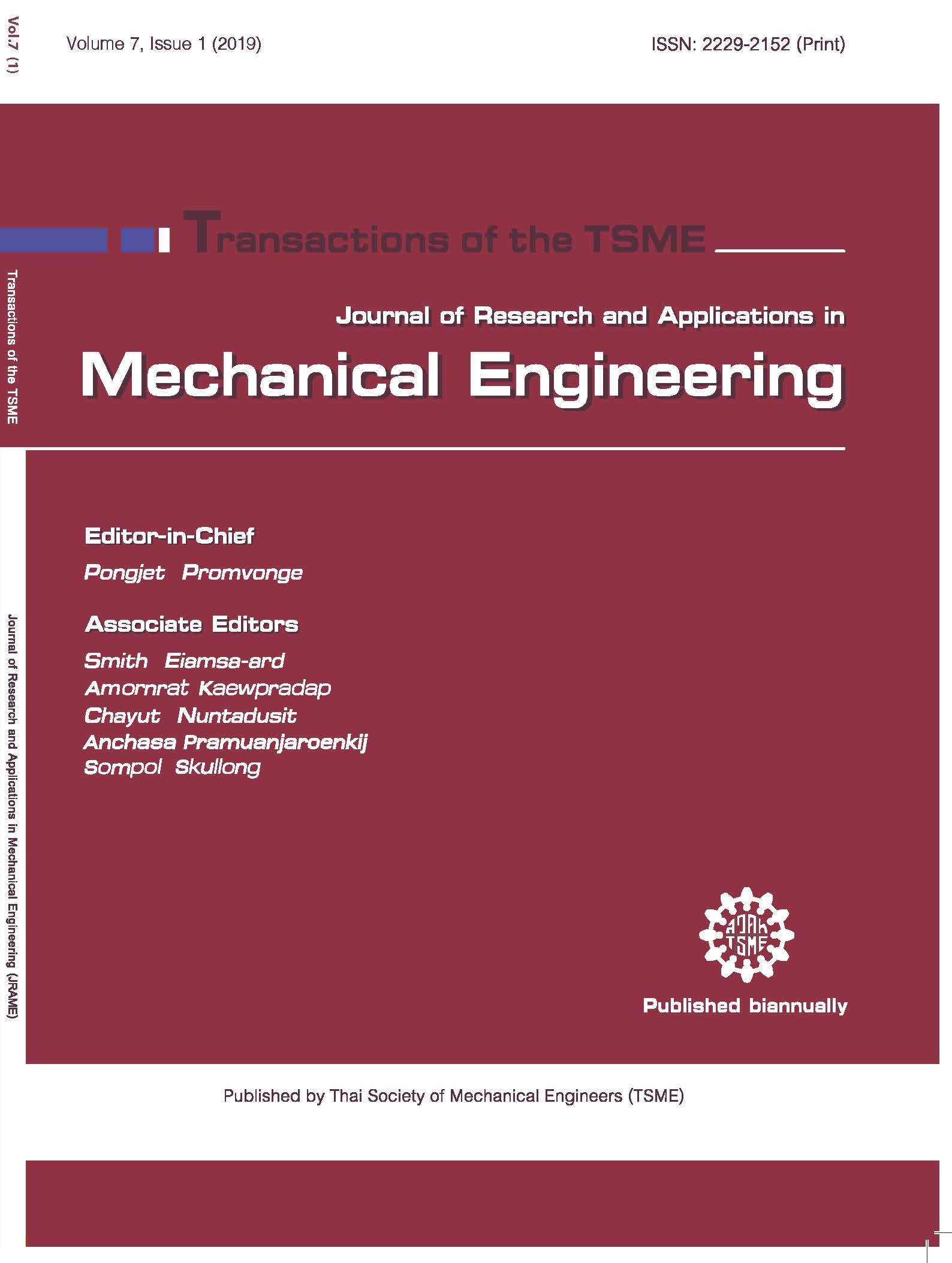The correction of Thai varus knee by high tibial osteotomy with Fujisawa’s point using finite element analysis
Main Article Content
Abstract
The patients of congenital varus knees may suffer from osteoarthritis symptoms which need corrective surgery on the deformed knees. High tibial osteotomy (HTO) with Fujisawa’s point is a complicated but effective treatment where the surgeon realigns the deformed varus knees to the normal knee position to preserve the ligaments, tendons and meniscus. The purpose of research was to evaluate the distributed stress and strain on the eight lower extremity models as follows: Thai varus knee, HTO corrected using Fujisawa’s point varied in 5 different lateral position, 30% lateral point of load-bearing axis, 33% lateral point of load-bearing axis, 35% lateral point of load-bearing axis, 38% lateral point of load-bearing axis and 40% lateral point of load-bearing axis, HTO corrected at the midpoint of proximal tibia, and knee joint inserted with total knee prosthesis. These eight lower extremity models were evaluated under daily activities using finite element method. The stress and strain distribution of the lower extremity using HTO with Fujisawa’s point were analyzed to indicate the most appropriate position to ensure that the stress and strain distribution does not exceed its maximum capacity; the femur would not break. HTO corrected using Fujisawa’s point of 40% lateral point of load-bearing axis, compared to other Fujisawa’s models, resulted in the maximum equivalent total strain closest to that of normal knee. However, knee joint inserted with total knee prosthesis resulted in strain distribution most similar to that of normal knee.
Article Details
This work is licensed under a Creative Commons Attribution-NonCommercial-ShareAlike 4.0 International License.
References
[2] New York-Presbyterian Morgan Stanley Children's Hospital, Bowleg and knock knees. URL: https://childrensorthopaedics.com/Bowlegand KnockKnees.html, accessed on 22/01/2013.
[3] Fujisawa, Y., Masuhara, K. and Shiomi, S. The effect of high tibial osteotomy on osteoarthritis of the knee: An arthroscopic study of 54 knee joints, Orthop. Clin. North Am., Vol. 10, 1979, pp. 585-608.
[4] Paley, D. Principles of Deformity Correction. 2002, Springer-Verlag, New York.
[5] Aroonjarattham, P., Aroonjarattham, K. and Suvanjumrat, C. Effect of mechanical axis on strain distribution after total knee replacement, J. Kasetsart (Nat. Sci.)., Vol. 48(2), 2014, pp. 263-282.
[6] Aroonjarattham, P., Aroonjarattham, K. and Chanasakulniyom, M. Biomechanical effect of filled biomaterials on distal Thai femur by finite element analysis, J. Kasetsart (Nat. Sci.)., Vol. 49(2), 2015, pp. 263-276.
[7] Knee Assessment. Inc., ©1997 Egton Medical Information Systems Limited, URL: https://www.patient.co.uk/doctor/knee-assessment, accessed on 5/05/2014.
[8] Jordan, A. The Anatomy and Function of the Knee Joint. Inc.; ©2013, URL: https://www.broadgatespinecentre.co.uk/the-anatomy-and-function-of-the-knee-joint/, accessed on 3/05/2014.
[9] Peraz, A., Mahar, A., Negus, C., Newton, P. and Impelluso, T. A computational evaluation of the effect of intramedullary nail material properties on the stabilization of simulated femoral shaft fracture, Med. Eng. Phys., Vol. 30(6), 2008, pp. 755-760.
[10] Bendjaballah, M.Z., Shiraz-Adi, A. and Zukor, D.J. Finite element analysis of human knee joint in varus-valgus, Clin. Biomech., Vol. 12, 1997, pp. 139-148.
[11] Weiss, J.A. and Gardine, J.C. Computational modeling of ligament mechanics, Crit. Rev. Biomed. Eng., Vol. 29, 2001, pp. 1-70.
[12] Monk, A.P., Van Oldenrijk, J., Nicholas, R.D., Richie, H.S.G. and Murray, D.W. Biomechanics of the lower limb, Surgery, Vol. 34(9), 2016, pp. 427-435.
[13] Ramos, A. and Simoes, J.A. Tetrahedral versus hexahedral finite elements in numerical modeling of the proximal femur, Med. Eng. Phys., Vol. 28, 2006, pp. 916-924.
[14] Heller, M.O., Bergman, G., Kassi, J.P., Claes, L., Hass, N.P. and Duda, G.N. Determination of muscle loading at the hip joint for use in pre-clinical testing, Biomechanics, Vol. 38, 2004, pp. 1155-1163.
[15] Frost, H.M. Wolff’s law and bone’s structural adaptation to mechanical usage: An overview for clinicians, The Angle Orthodontist, Vol. 64(3), 1994, pp. 175-188.
[16] Frost, H.M. A 2003 update of bone physiology and Wolff’s law for clinicians, Angle Orthodontis, Vol. 74, 2003, pp. 3-15.
[17] Black, J. and Hastings, G. Handbook of biomaterials properties, 1998, Chapman & Hall, UK.
[18] Benzakour, T., Hefti, A., Lemseffer, M., El Ahmadi, J.D., Bouyarmane, H. and Benzakour, A. High tibial osteotomy for medial osteoarthritis of the knee: 15 years follow-up, Int. Orthop., Vol. 34, 2010, pp.209-215.
[19] Michaela, G., Florian, P., Michael, L. and Christian, B. Long-term outcome after high tibial osteotomy, Arch. Orthop. Trauma. Surg., Vol. 128, 2008, pp. 111-115.
[20] Sprenger, T.R. and Doerzbacher, J.F. Tibial osteotomy for the treatment of varus gonarthrosis, Survival and failure analysis to twenty-two years, J. Bone Joint Surg. Am., Vol. 85-A(3), 2003, pp. 469-474.



